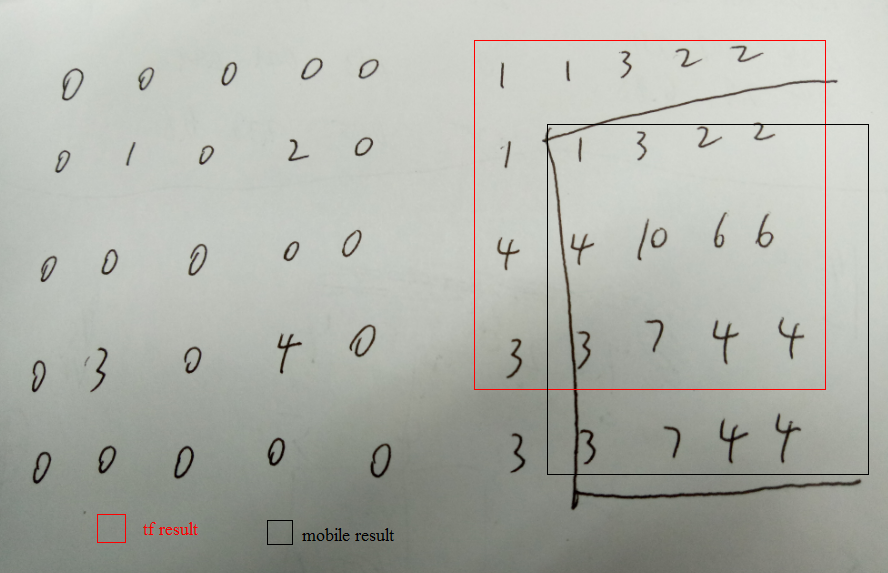1.padding test

input = tf.placeholder(tf.float32, shape=(1,2, 2,1)) simpleconv=slim.conv2d(input,1,[3,3],stride = 1,activation_fn = None,scope = 'simpleconv3') sess.run(tf.global_variables_initializer()) weights=graph.get_tensor_by_name("simpleconv3/weights:0") sess.run(tf.assign(weights,tf.constant(1.0,shape=weights.shape))) a=np.ndarray(shape=(1,2,2,1),dtype='float',buffer=np.array([1.0,2,3,4])) simpleconvout=sess.run(simpleconv,feed_dict={input:a.astype('float32')}) print simpleconvout [[[[ 10.000000] [ 10.000000]] [[ 10.000000] [ 10.000000]]]] input1 = tf.placeholder(tf.float32, shape=(1,4, 4,1)) simpleconv=slim.conv2d(input1,1,[3,3],stride = 2,activation_fn = None,scope = 'simpleconv3') sess.run(tf.global_variables_initializer()) weights=graph.get_tensor_by_name("simpleconv3/weights:0") sess.run(tf.assign(weights,tf.constant(1.0,shape=weights.shape))) a=np.ndarray(shape=(1,4,4,1),dtype='float',buffer=np.array([1.0,2,3,4,2,3,4,5,3,4,5,6,4,5,6,7])) simpleconvout=sess.run(simpleconv,feed_dict={input1:a.astype('float32')}) print simpleconvout [[[[ 27.] [ 27.]] [[ 27.] [ 24.]]]] simpledeconv=slim.conv2d_transpose(input,1,[3,3],stride = 2,activation_fn = None,scope = 'simpledeconv') sess.run(tf.global_variables_initializer()) weights=graph.get_tensor_by_name("simpledeconv/weights:0") sess.run(tf.assign(weights,tf.constant(1.0,shape=weights.shape))) a=np.ndarray(shape=(1,2,2,1),dtype='float',buffer=np.array([1.0,2,3,4])) simpleconvout=sess.run(simpledeconv,feed_dict={input:a.astype('float32')}) print simpleconvout [[[[ 1.000000] [ 1.000000] [ 3.000000] [ 2.000000]] [[ 1.000000] [ 1.000000] [ 3.000000] [ 2.000000]] [[ 4.000000] [ 4.000000] [ 10.000000] [ 6.000000]] [[ 3.000000] [ 3.000000] [ 7.000000] [ 4.000000]]]] conv stride=1是四周padding 0,stride=2是down right padding 0 deconv是top left各插了两行0 而torch中的deconv是四周padding一圈0
参考http://blog.csdn.net/lujiandong1/article/details/53728053
'SAME' padding方式时,如果padding的数目是奇数,则多的padding在右边(下边)
2.实现custom-padding
https://stackoverflow.com/questions/37659538/custom-padding-for-convolutions-in-tensorflow

实现custom conv decon def conv(input,num_outputs,kernel_size,stride=1,padW=0,padH=0,activation_fn=None,scope=None): padded_input = tf.pad(input, [[0, 0], [padH, padH], [padW, padW], [0, 0]], "CONSTANT") return slim.conv2d(padded_input,num_outputs,kernel_size,stride = stride,padding="VALID",activation_fn = activation_fn ,scope = scope) input1 = tf.placeholder(tf.float32, shape=(1,4, 4,1)) a=np.ndarray(shape=(1,4,4,1),dtype='float',buffer=np.array([1.0,2,3,4,2,3,4,5,3,4,5,6,4,5,6,7])) simpleconv=conv(input1,1,[3,3],stride = 2,padW=1,padH=1,activation_fn = None,scope = 'conv') sess.run(tf.global_variables_initializer()) weights=graph.get_tensor_by_name("conv/weights:0") sess.run(tf.assign(weights,tf.constant(1.0,shape=weights.shape))) simpleconvout=sess.run(simpleconv,feed_dict={input1:a.astype('float32')}) print simpleconvout [[[[ 8.] [ 21.]] [[ 21.] [ 45.]]]] def deconv(input,num_outputs,kernel_size,stride=2,activation_fn=None,scope=None): N,H,W,C = [i.value for i in input.get_shape()] out = slim.conv2d_transpose(input,num_outputs,kernel_size,stride = stride,padding="VALID",activation_fn = activation_fn ,scope = scope) return tf.slice(out, [0, kernel_size[0]/2,kernel_size[1]/2, 0], [N, H*stride, W*stride,num_outputs]) input = tf.placeholder(tf.float32, shape=(1,2, 2,1)) a=np.ndarray(shape=(1,2,2,1),dtype='float',buffer=np.array([1.0,2,3,4])) simpledeconv=deconv(input,1,[3,3],stride = 2,activation_fn = None,scope = 'simpledeconv1') sess.run(tf.global_variables_initializer()) weights=graph.get_tensor_by_name("simpledeconv1/weights:0") sess.run(tf.assign(weights,tf.constant(1.0,shape=weights.shape))) out=sess.run(simpledeconv,feed_dict={input:a.astype('float32')}) print out [[[[ 1.] [ 3.] [ 2.] [ 2.]] [[ 4.] [ 10.] [ 6.] [ 6.]] [[ 3.] [ 7.] [ 4.] [ 4.]] [[ 3.] [ 7.] [ 4.] [ 4.]]]]


